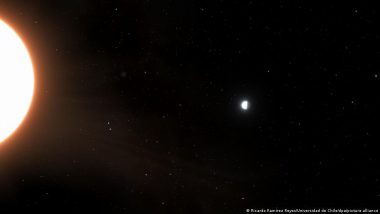Researchers have found an intensely hot exoplanet with metallic clouds that rain titanium. The strange world, rather prosaically known as LTT9779b, is the brightest planet discovered outside the solar system.Scientists on Monday announced the discovery of a scorching world with temperatures of up to 2,000 degrees Celsius (over 3,600 degrees Fahrenheit), where glass-like silicate and metals boil into clouds.
Also Read | AI Lab in India: Dell Technologies Joins Intel to Launch Artificial Intelligence Skills Lab in Telangana.
The announcement was published by the European Space Agency (ESA).
Also Read | Monsoon Rains in Northern India Leave Several Dead.
The brightest planet to be discovered outside our solar system to date, LTT9779b has been described by researchers as "a planet that shouldn't exist."
What we know about the planet
The planet — about the size of Neptune— lies close to its star, orbiting it every 19 hours. It's the star-facing side of the planet that has a temperature of about 2,000 degrees Celsius.
LTT9779b — some 260 light years from Earth— was initially discovered by NASA in 2020, but the latest discoveries were made in a follow-up study by the European Space Agency's exoplanet-spotting Cheops space telescope. Researchers found the planet was a conundrum from the very beginning because of its high reflectiveness, also called albedo in scientific terminology.
Most planets and moons have a low albedo because they absorb, rather than reflect, light. Exceptions include ice worlds like Jupiter's satellite Europa or cloudy ones like Venus.
Although it reflects "like a mirror," the researchers said LTT9779b seemed too hot for clouds, even if they were made of metal or glass. However, it turned out that the atmosphere of LTT9779b is so saturated with metals and silicate vapors that droplets do form — including raindrops composed of titanium.
"To steam up a bathroom you can either cool the air until water vapor condenses, or you can keep the hot water running until clouds form because the air is so saturated with vapor that it simply can't hold anymore," said Vivien Parmentier, co-author of a study in the journal Astronomy and Astrophysics.
"Similarly, LTT9779 b can form metallic clouds despite being so hot because the atmosphere is oversaturated with silicate and metal vapors."
Hot Neptune puzzle
Another curiosity was that planets the size of LTT9779b that have an atmosphere shouldn't exist so close to their sun — normally the outer layer would simply burn away.
"It's a planet that shouldn't exist," said Parmentier. "We expect planets like this to have their atmosphere blown away by their star, leaving behind bare rock."
The answer was partly explained by the high reflectivity, allowing LTT9779b to exist in what scientists term a "hot Neptune desert."
"The clouds reflect light and stop the planet from getting too hot and evaporating," said paper co-author Sergio Hoyer. "Meanwhile, being highly metallic makes the planet and its atmosphere heavy and harder to blow away."
To determine the properties of the planet, scientists looked at differences in light when the planet was technically "visible" and when it was eclipsed by its own star. Only with the precision of the Cheops telescope — focused on discovering new exoplanet systems — was it possible to measure the data the team needed this time around.
The scientists hope to follow up with other data from the Hubble and James Webb space telescopes, which they say will provide a fuller picture.
Edited by: Alex Berry
(The above story first appeared on LatestLY on Jul 10, 2023 06:30 PM IST. For more news and updates on politics, world, sports, entertainment and lifestyle, log on to our website latestly.com).













 Quickly
Quickly




















